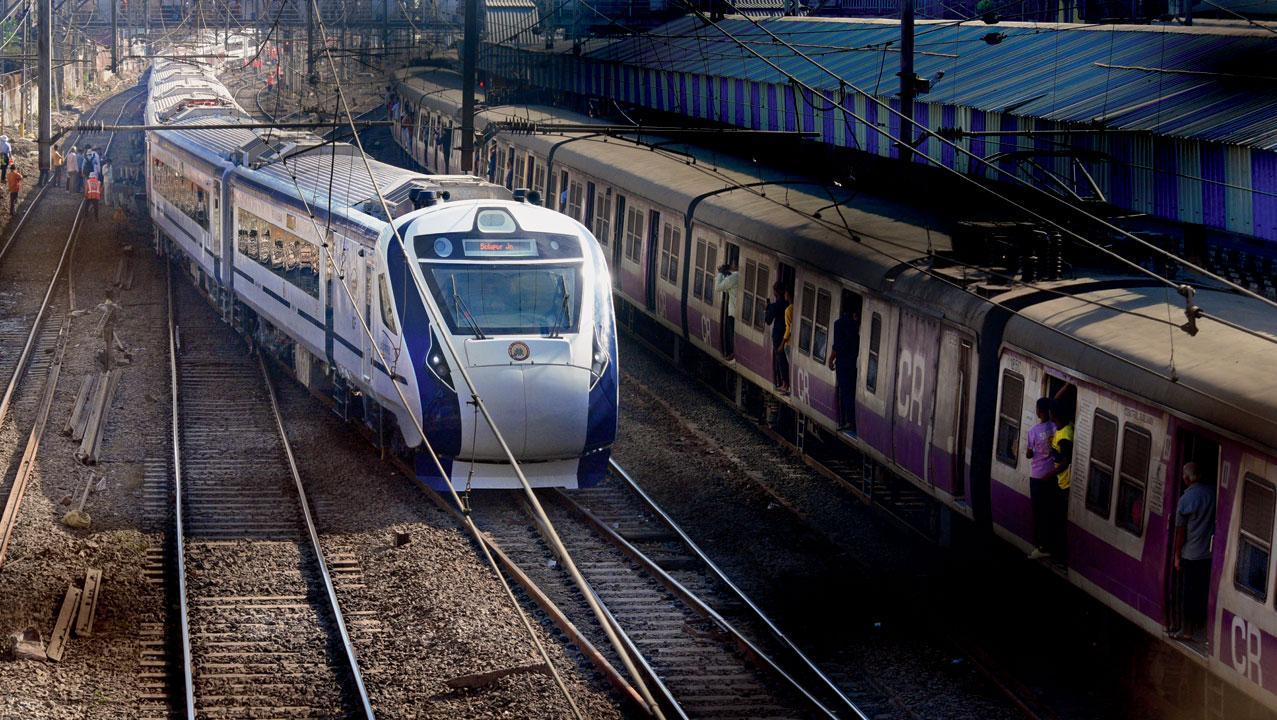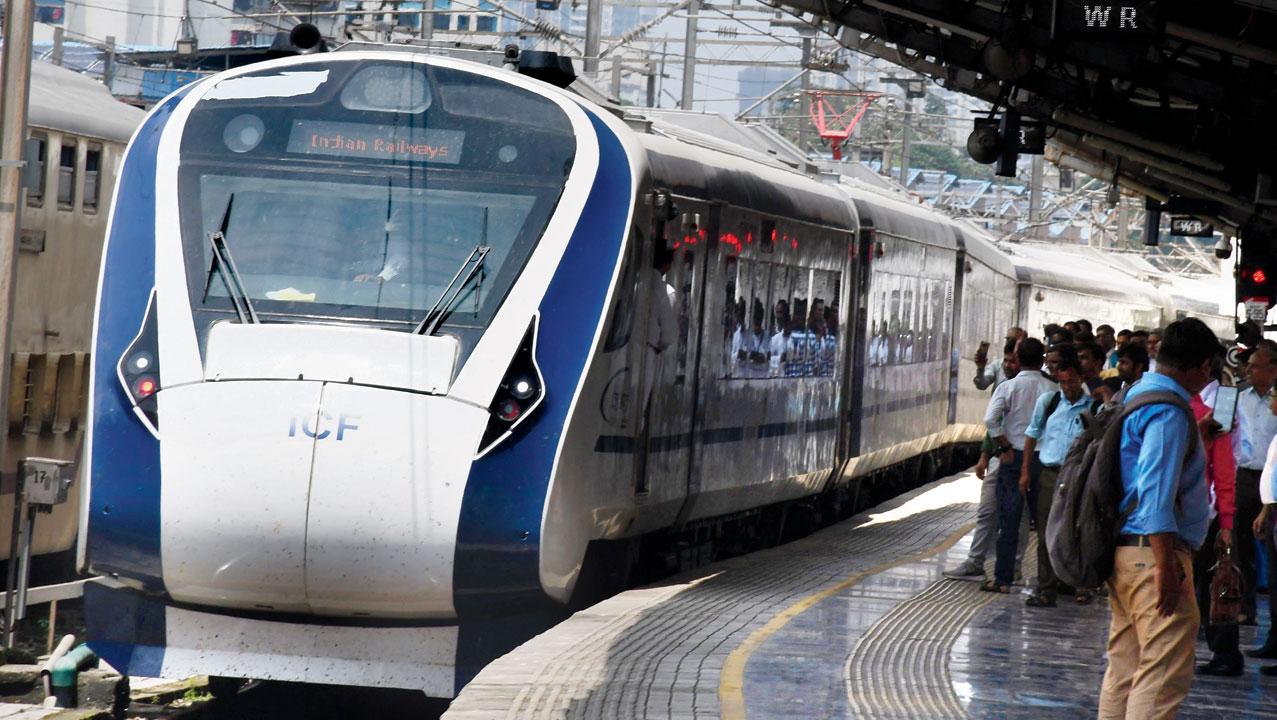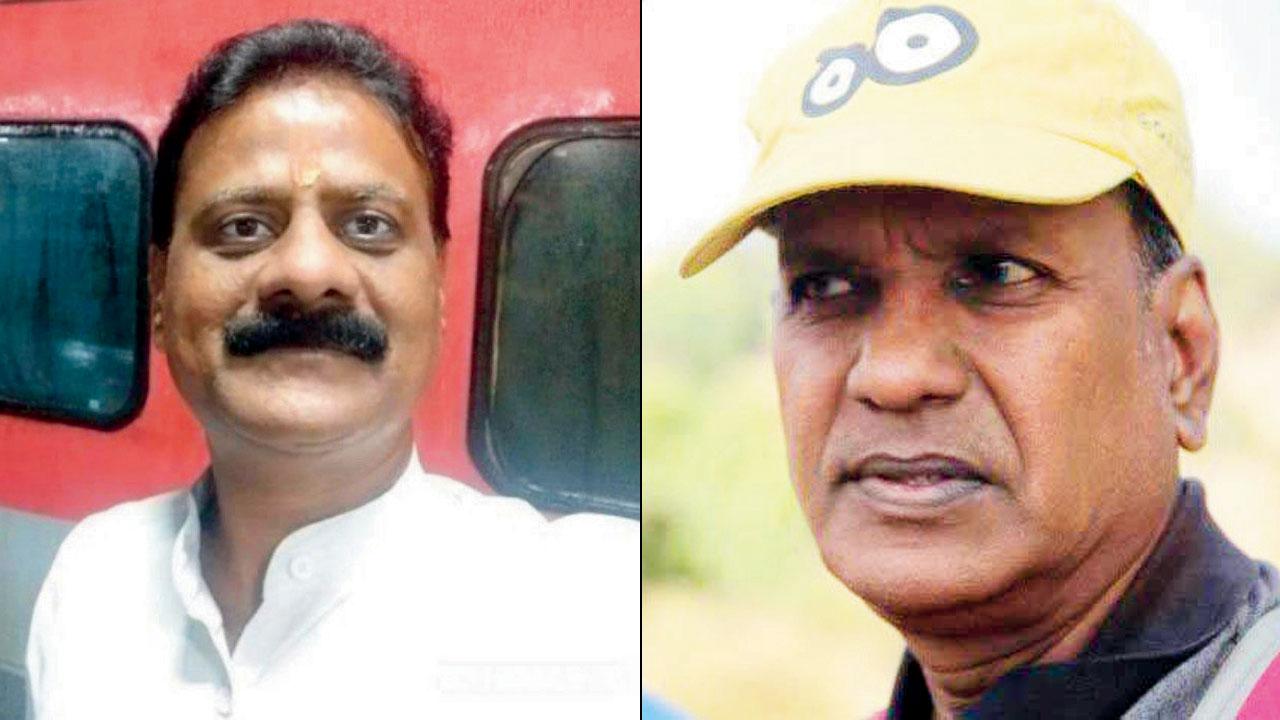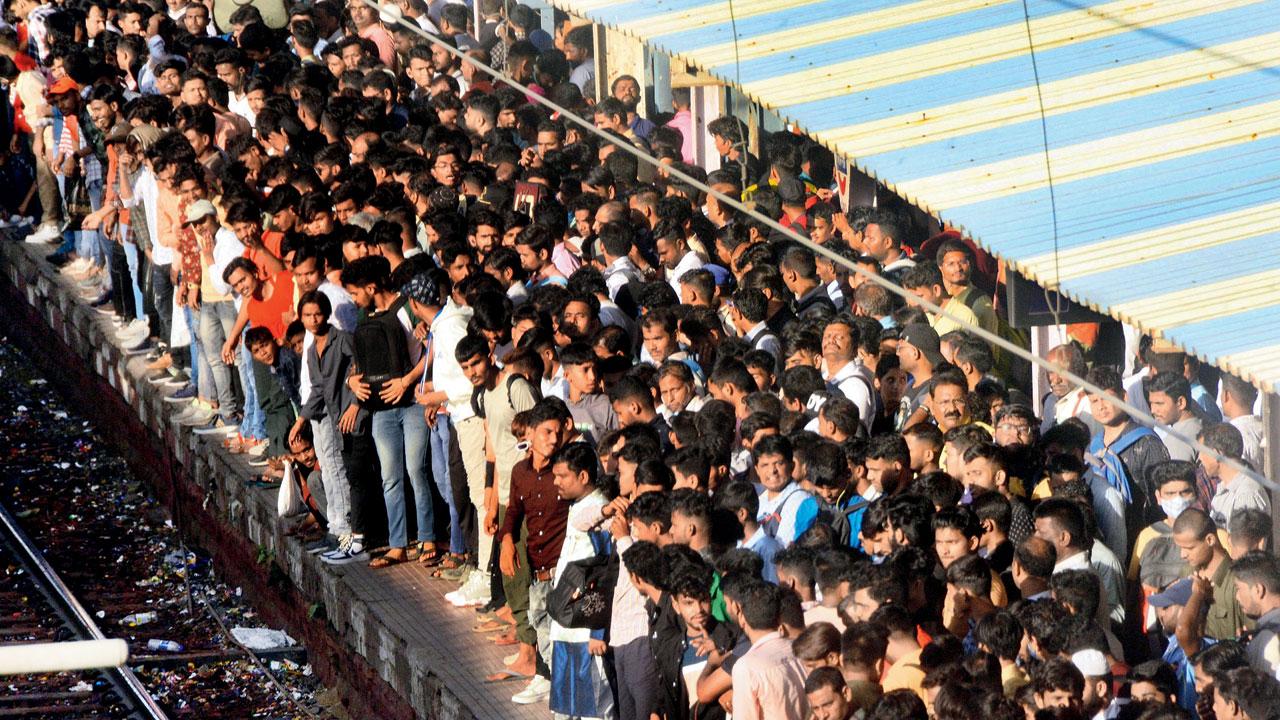In a surprise Friday night announcement, Mumbai’s future AC locals got upgraded to Vande Metro trains, which on the best of days promise faster, cooler travel; on the worst, to sail you through the floods. Railways insiders, transport gurus and long-time commuters weigh in on what this means for Mumbai

The Vande Metro train will be modelled on the Vande Bharat Express, have 10 pc extra carrying capacity, sealed gangways and coaches earmarked for ladies, physically disabled and seniors. Pic/Satej Shinde
 One hundred and seventy years ago, on a hot and sultry April 16 afternoon, a 14-coach train bedecked with garlands and flowers, and pulled by three steam engines, started its journey at the boom of cannons atop St George’s Fort and to the tune of Bombay Governor’s band, from a small wooden structure called Boree Bunder station. It was an adventurous journey with a hissing and puffing steam engine spewing hot steam, water, soot and smoke on open-windowed passengers along the way. The train, packed with 400 guests, officials and dignitaries, reached the township of Thane (Tannah), about 21 miles away, within 57 minutes flat, marking the advent of the railways in India.
One hundred and seventy years ago, on a hot and sultry April 16 afternoon, a 14-coach train bedecked with garlands and flowers, and pulled by three steam engines, started its journey at the boom of cannons atop St George’s Fort and to the tune of Bombay Governor’s band, from a small wooden structure called Boree Bunder station. It was an adventurous journey with a hissing and puffing steam engine spewing hot steam, water, soot and smoke on open-windowed passengers along the way. The train, packed with 400 guests, officials and dignitaries, reached the township of Thane (Tannah), about 21 miles away, within 57 minutes flat, marking the advent of the railways in India.
ADVERTISEMENT
The steam trains ran in and around Bombay’s suburbs for 72 years, after which they were slowly converted into electric trains circa 1925. Running 22 hours a day, it became the most reliable and dependable public transport, the lifeline that connected the moving population with the rest of the city. On December 25, 2017, fully air-conditioned locals were introduced into the network for the first time, changing the dynamics of comfortable public travel in the city.

Vande Metro will have the look and feel of the recently-launched Vande Bharat trains with customised features to make travel inclusive. Pic/Ashish Raje
This week, in a historic shift for Mumbai’s lifeline, the Ministry of Railways announced a decision that some believe will revolutionise local suburban train travel. On Friday, it issued a one-sheet, five-point note to the Mumbai Railway Vikas Corporation (MRVC), the rail upgrade, project planning and implementation body for the city, directing it to upgrade Mumbai local trains into the classy, Vande Metro (suburban) trains. The MRVC has been instructed to place orders for the “procurement of 238 trains of Vande Metro (suburban) under the Mumbai Urban Transport Project (MUTP) 3 and 3A”. The MUTP projects are jointly funded by the state and the central government to upgrade the city’s rail network with new corridors and trains.
Also Read: Mumbai locals to be upgraded: Indian Railways order procurement of 238 trains of Vande Metro
The note further states that the trains will not be manufactured in the government-run railway factories, but by technology partners who will be roped in on contract-basis. These partners will have to adhere to the Make in India guidelines. In addition to this, the two car depots already approved under MUTP III & 3A projects at Vangaon on Western Railway and Bhivpuri on Central Railway will be set up by the technology partner. The ministry has already given the MRVC the green signal to invite tenders for the project with stringent maintenance requirements for the next 35 years. The planning body will have to consult the Western and Central Railway for requirement of 12/15 car trains. “The decision to procure Vande Metro (suburban) trains reflects the government’s long-term vision for suburban rail networks and emphasises its commitment to providing world-class transportation facilities to commuters. The introduction of these state-of-the-art trains will undoubtedly elevate the suburban travel experience,” said SC Gupta, chairman and managing director, MRVC.
Not-so-cool comfort
The idea for the AC local train was first mooted in 2002, to combat deaths caused by overcrowded trains. According to an RTI query by the Government Railway Police, between 2005 and 2015, “25,722 passengers fell from suburban trains [travelling on Western, Central and Harbour suburban services in Mumbai Commissionerate], of whom 6,989 commuters died while 18,733 survived”. Last year, 700 died after reportedly falling off running trains.

Subhash Gupta and Jitendra Gupta
Numerous experiments were conducted to run the existing trains with doors closed, but it led to a dip in oxygen levels causing suffocation. When a new set of local trains arrived in 2007, a concept of “forced ventilation” was brought in, but it did not work well as there were multiple technical snags in the ventilation system, and the doors remained open.
Finally, in 2016, the plan to introduce AC trains was worked out, with the first train becoming operational a year later. The AC local train was labelled as a sister of Vande Bharat (Train 18)—India’s first engine-less, semi-high speed train—manufactured in 2018, by the Integral Coach Factory in Chennai. Both the trains have similar features like underslung electrics and technology with more horsepower and better acceleration. But the Railways’ decision to have a different fare structure, higher than that of the existing first class, pushed away a section of regular commuters. When it launched, the minimum fare touched R65, which was almost five times more than the regular fare.
More than a boon, it turned out to be an irritant for commuters, because the AC trains had replaced some of the regular train services, and passengers without “premium tickets” couldn’t board the AC train. Majority of the commuters chose not to take the AC local, causing further chaos. For instance, after every AC train, the platform would get crowded, leading to a rise in accidents.
In August 2022, a group of commuters staged a rail roko to protest the Railways’ decision to change the 8.20 non-AC Thane-CSMT train into an AC local service. Soon after, several politicians joined the bandwagon—NCP president Sharad Pawar called for the complete withdrawal of the AC trains from the city and restoration of regular services for the “working-class commuters”. The CR was then forced to withdraw 10 AC services citing law and order issues.

The Vande Metro will be modelled on the advanced AC local that arrived in December 2022 in Mumbai, and will be able to accommodate more passengers inside the coaches
Another issue that affected commuters was that the new AC trains were not customised for the city. mid-day last year had highlighted how these AC trains did not have space for the city’s traditional commuters, like the dabbawallahs, fishermen and other luggage bearers. Following the reports, the railways promised to incorporate design changes in the future trains to make them more inclusive.
One of the many suggestions that came from passengers was to convert the existing local trains into partial AC trains. Yeshwant Jadyar of Virar-Sawantwadi KR Passenger Association said that they had discussed making the last three coaches air-conditioned. “Given the fact that only 30 per cent of the passengers use AC trains, it made sense attaching three AC coaches to the existing 12-car train. This would mean making all existing trains 15-car coaches,” says Jadyar.
A similar suggestion had come from former managing director of MRVC, Dr PC Sehgal, who had also met the then general manager of Western Railway, AK Gupta, requesting that the Railways introduce semi-AC locals so that they can be accessed by all classes of people.
At present, there are only 14 AC local trains in Mumbai—12 with electrics from Bharat Heavy Electricals Limited (BHEL), one detachable train with electricals from Medha Servo Drives Pvt Ltd, and another one with underslung equipment. As per official figures, while Western Railway runs 76 services with about six trains, Central Railway runs five trains with 56 services. The last AC train for Mumbai was dispatched from Integral Coach Factory (ICF) on November 30 last year; it arrived in the city in December 2022. No more trains were expected or ordered after that.
Revolutionising travel
Vande Metro is a concept name given to the AC local trains that will be procured for Mumbai. “The train will have similar functionalities like that of Vande Bharat trains and will be customised as Mumbai suburban trains. One specific feature of the Vande Metro train is that the train will have a luggage compartment at either end of the train with a separate AC duct. Besides this, the train will have CCTVs,” said MRVC CMD Gupta. It will also have a separate AC duct for the vendors compartment, so that the smell of fish does not spread across compartments.

The Vande Metro will be modelled on the advanced AC local that arrived in December 2022 in Mumbai, and will be able to accommodate more passengers inside the coaches
Sources said Vande Metro will be similar to the advanced version of AC local train that arrived in Mumbai in December last year. This particular 12-car walkthrough, vestibuled AC local train, with all electricals and equipment underslung near the wheels, is able to ferry more passengers than regular AC trains. It has flexi solar panels on the roof that are light in weight and capable of generating 3.6 kw of electricity. These panels will power the fans and lights of the coach, reducing the power needs from the overhead power supply. This has been experimented in one coach of the train and depending on the feedback, the innovation will be extended to other coaches.
Senior railway official Sudhanshu Mani and former General Manager of Integral Coach Factory, who is known as the father of Vande Bharat (Train 18) trains, said, this advanced AC local is one-of-a-kind. “It has underslung electrics leaving the entire on-board space for passengers—the carrying capacity has gone up by about 10 per cent. The sealed gangways [the link between coaches] have been made wider, allowing one to walk end to end. It also has more power and better acceleration. The underslung unit has been fitted in such a way that the train can even run in a flooded track at a slow speed. Since it’s an EMU [Electric Multiple Unit], any number of coaches can be added in multiples,” he said.
‘Fare will be burning issue’
While passenger associations have welcomed the decision to introduce Vande Metro on the local line, the premium fare rates, they feel, will continue to be a cause for concern. “The average Mumbaikar cannot afford to travel in the AC local. The rates for Vande Metro won’t be any different.... The fare for a single journey should at least be brought at par with Metro trains, otherwise it won’t be accepted,” said Subhash Gupta, a member of one such association.
Ashok Datar, senior transport expert and chairman of Mumbai Environmental Social Network Ashok Datar, said that before mooting any new proposal, the authorities should work out the logistics and understand the demand for AC versus non-AC locals in the city. “It is a very important subject in view of the Railways’ plans to convert the entire suburban section into AC trains,” he says, adding, “The Railways should make public, the figures of availability of AC trains and daily ridership by class and let it be discussed by the people. This gap should be reduced in an intelligent manner.”
Jitendra Gupta, resident of Kurla West and a founder member of Citizen Transport Committee, fears that the Harbour line, will continue to be treated poorly. “If such a plan has been mooted for CR and WR, the Railways must ensure similar trains are run on all corridors.”
What to expect from Vande Metro
>> Automatic door closing system and fully vestibule coaches
>> Single class of coaches
>> Separate AC vendor compartment at both ends of train
>> Passenger seating arrangement is same as per the existing EMU trains and modular ergonomic seats
>> Coaches will be earmarked for ladies, physically disabled and senior citizens as per the existing arrangement
>> Energy efficient LED lights in the coaches
>> Infotainment for passengers with large digital display panels and indications for stations
>> Emergency egress system
>> CCTV surveillance and passenger talk back system
>> Stainless steel fittings for better aesthetics
238
No of Vande Metro trains that MRVC has been instructed to procure
 Subscribe today by clicking the link and stay updated with the latest news!" Click here!
Subscribe today by clicking the link and stay updated with the latest news!" Click here!







